Blog Post
Exploring Metrnl: Unveiling the Dynamics of Interleukin-41
In the complex landscape of immune signaling molecules, Metrnl, also known as Interleukin-41 (IL-41), emerges as a relatively recent discovery with intriguing potential. This blog post delves into the lesser-known realm of Metrnl/IL-41, unraveling its functions, implications in immune regulation, and the evolving landscape of immunotherapy research.
Decoding Metrnl/Interleukin-41 (IL-41)
Metrnl, formerly recognized as IL-41, belongs to the interleukin family, critical for mediating immune responses and maintaining immune system balance. While research on Metrnl/IL-41 is still burgeoning, several key aspects have come to light:
- Immune Cell Modulation: Metrnl/IL-41 plays a role in the activation and regulation of various immune cells, including T cells, B cells, and dendritic cells. Its precise mechanisms in immune cell signaling pathways are subjects of ongoing investigation.
- Inflammatory Dynamics: Metrnl/IL-41 exhibits both pro-inflammatory and anti-inflammatory effects, contributing to the nuanced regulation of immune responses. Understanding its influence on inflammatory cascades and cytokine networks is a focus of current research.
- Tissue-Specific Actions: Initial studies suggest that Metrnl/IL-41 may demonstrate tissue-specific functions, influencing immune cell behavior and immune surveillance in distinct anatomical contexts.
- Disease Associations: While direct associations with specific diseases are still under exploration, Metrnl/IL-41’s expression patterns and interactions with other immune molecules hint at potential roles in autoimmune disorders, inflammatory conditions, and possibly cancer immunity.
Potential Implications in Immunotherapy
The emergence of Metrnl/IL-41 as a novel cytokine has sparked interest in its potential implications for immunotherapy and disease management:
- Autoimmune Disorders: Investigating Metrnl/IL-41’s role in immune dysregulation may reveal new therapeutic avenues for autoimmune diseases, offering innovative treatment strategies.
- Inflammatory Conditions: Understanding Metrnl/IL-41’s impact on inflammatory pathways could lead to targeted therapies for chronic inflammatory diseases, addressing unmet clinical needs.
- Cancer Immunology: Given the intricate interplay between cytokines and tumor microenvironments, exploring Metrnl/IL-41’s effects on anti-tumor immunity holds promise for advancements in cancer immunotherapy.
Challenges and Future Directions
While the potential of Metrnl/IL-41 is vast, research faces challenges such as the need for specific reagents, comprehensive functional studies, and understanding its interactions within complex immune networks. Future directions may include:
- Mechanistic Insights: Unraveling the molecular mechanisms underlying Metrnl/IL-41 signaling and its crosstalk with other immune mediators to elucidate its precise functions.
- Therapeutic Targeting: Utilizing Metrnl/IL-41 as a therapeutic target requires in-depth characterization of its roles in disease pathogenesis and immune regulation.
- Clinical Applications: Translating Metrnl/IL-41 discoveries into clinical applications, focusing on personalized immunotherapies and precision medicine approaches.
Conclusion
Metrnl, also recognized as Interleukin-41 (IL-41), represents a promising frontier in immunology, with potential implications spanning autoimmune disorders, inflammatory conditions, and cancer immunotherapy. As research continues to unveil Metrnl/IL-41’s functions and therapeutic relevance, it may emerge as a pivotal player in shaping future immunotherapeutic strategies.


